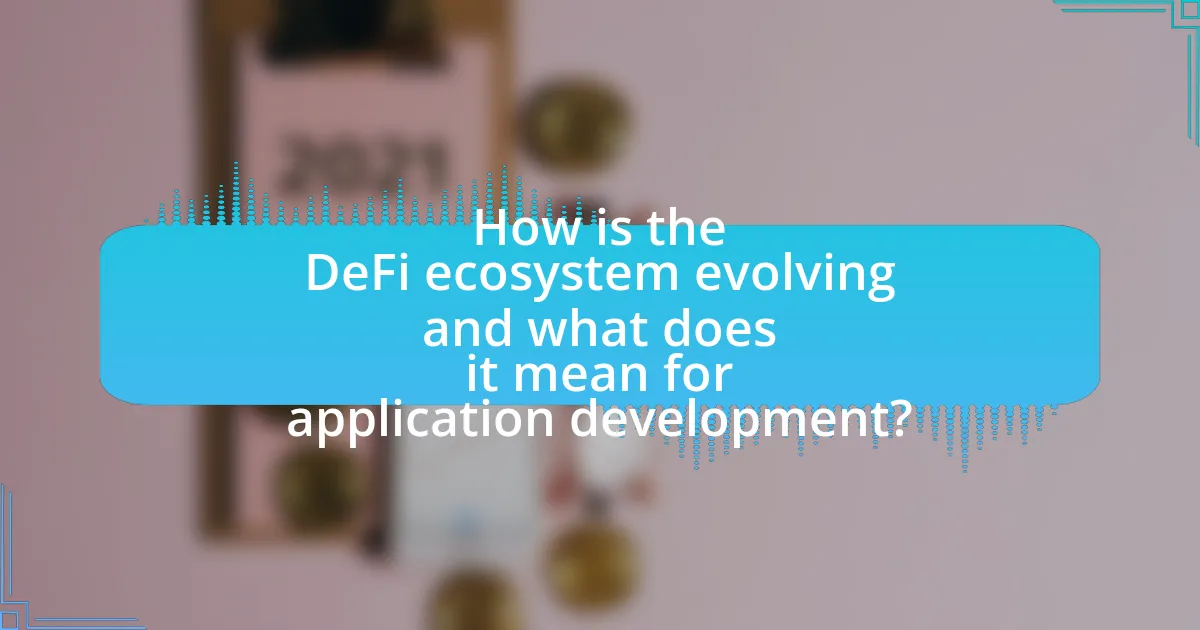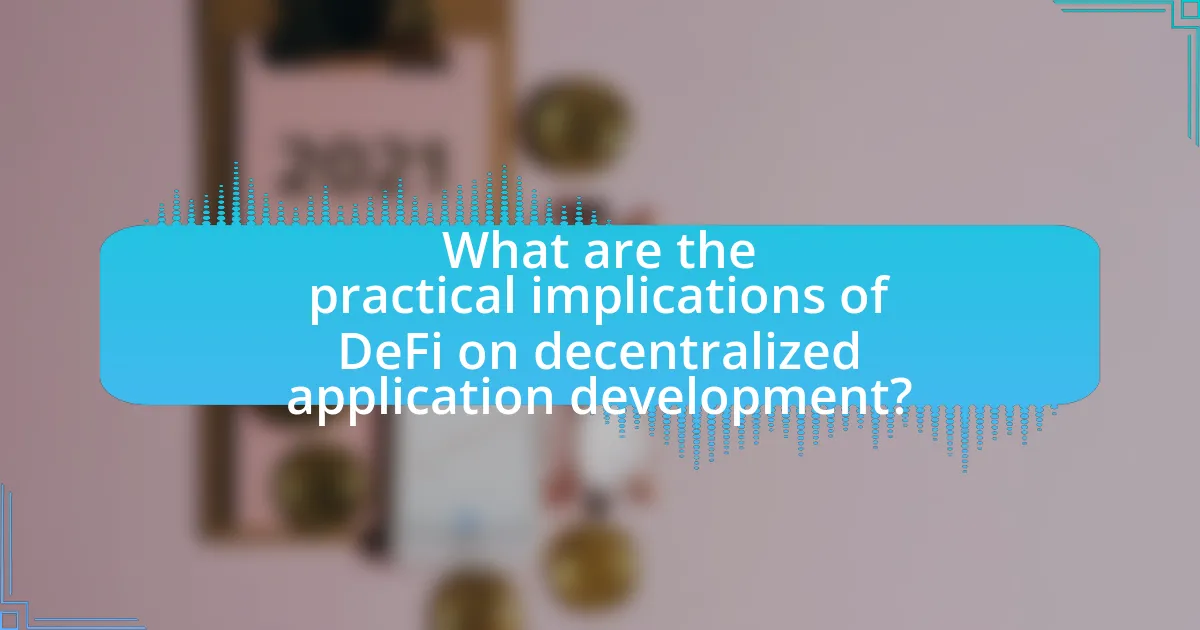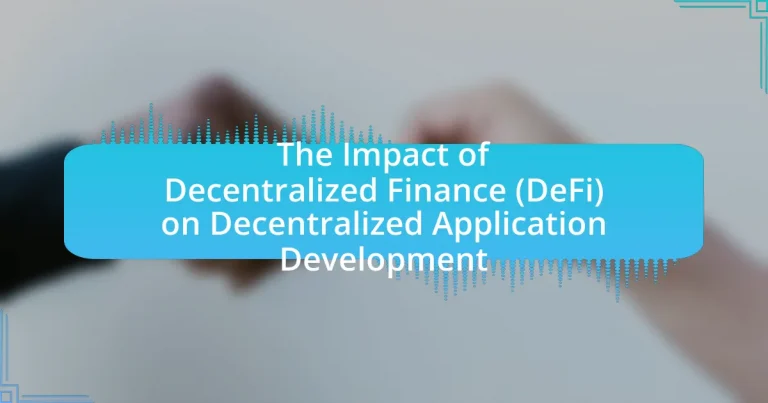Decentralized Finance (DeFi) plays a crucial role in accelerating the development of decentralized applications (dApps) by providing essential financial infrastructure, such as smart contracts, liquidity pools, and decentralized exchanges. The article explores how DeFi influences the architecture of dApps through interoperability, modularity, and composability, enabling developers to create innovative financial products. It also addresses the key features of DeFi that impact application development, including decentralization and transparency, while highlighting the challenges developers face, such as regulatory uncertainty and security risks. Furthermore, the article discusses emerging trends in the DeFi ecosystem, the importance of community involvement, and best practices for ensuring security and compliance in DeFi applications.
-on-Decentralized-Application-Development-1.webp)
What is the Impact of Decentralized Finance (DeFi) on Decentralized Application Development?
Decentralized Finance (DeFi) significantly accelerates decentralized application (dApp) development by providing essential financial infrastructure and protocols that developers can leverage. This impact is evident as DeFi platforms offer smart contracts, liquidity pools, and decentralized exchanges, which streamline the creation of financial services within dApps. For instance, the total value locked in DeFi protocols reached over $100 billion in 2021, demonstrating the robust ecosystem that developers can tap into for building innovative applications. Consequently, the availability of these resources fosters rapid experimentation and iteration in dApp development, enabling developers to create more complex and user-friendly financial products.
How does DeFi influence the architecture of decentralized applications?
DeFi significantly influences the architecture of decentralized applications by promoting interoperability, modularity, and composability. Interoperability allows different DeFi protocols to communicate and work together, enabling developers to create applications that leverage multiple services seamlessly. Modularity encourages the use of distinct components or smart contracts that can be independently developed and updated, enhancing flexibility and reducing development time. Composability allows developers to build on existing DeFi protocols, creating complex financial products by stacking various functionalities, which fosters innovation and rapid iteration. This architectural shift is evidenced by the rise of platforms like Uniswap and Aave, which exemplify how DeFi protocols can be integrated into broader decentralized applications, thus reshaping the landscape of application development in the blockchain ecosystem.
What are the key features of DeFi that affect application development?
The key features of DeFi that affect application development include decentralization, interoperability, composability, and transparency. Decentralization allows developers to create applications without relying on a central authority, fostering innovation and reducing single points of failure. Interoperability enables different DeFi protocols to work together seamlessly, allowing developers to build applications that can leverage multiple platforms and services. Composability allows developers to combine existing DeFi protocols and services to create new applications, enhancing functionality and user experience. Transparency ensures that all transactions and smart contracts are publicly accessible, which builds trust and facilitates auditing. These features collectively empower developers to create robust, innovative, and user-centric decentralized applications.
How do smart contracts play a role in DeFi application development?
Smart contracts are essential in DeFi application development as they automate and enforce the terms of financial agreements without intermediaries. By utilizing blockchain technology, smart contracts ensure transparency, security, and trust in transactions, which are critical for decentralized finance. For instance, platforms like Uniswap and Aave rely on smart contracts to facilitate automated trading and lending processes, respectively, allowing users to interact directly with the protocol. This automation reduces operational costs and enhances efficiency, as evidenced by the rapid growth of DeFi, which reached over $100 billion in total value locked by mid-2021, demonstrating the effectiveness of smart contracts in enabling decentralized financial services.
What challenges does DeFi present for decentralized application developers?
DeFi presents several challenges for decentralized application developers, primarily including regulatory uncertainty, security vulnerabilities, and interoperability issues. Regulatory uncertainty arises as developers navigate a rapidly evolving legal landscape, which can impact the viability and compliance of their applications. Security vulnerabilities are critical, as DeFi platforms have been targets for hacks and exploits, with losses exceeding $1 billion in 2021 alone, necessitating robust security measures. Interoperability issues occur when different DeFi protocols and blockchains lack seamless integration, complicating user experience and limiting functionality. These challenges require developers to adopt innovative solutions and maintain vigilance to ensure the success and safety of their applications.
What security risks are associated with DeFi in application development?
Security risks associated with DeFi in application development include smart contract vulnerabilities, which can lead to exploits and financial losses. For instance, the DAO hack in 2016 resulted in a loss of $60 million due to a flaw in the smart contract code. Additionally, DeFi applications face risks from oracle manipulation, where external data feeds can be compromised, affecting price feeds and leading to incorrect transaction outcomes. Furthermore, inadequate security audits can leave applications exposed to attacks, as seen in the case of the bZx protocol, which suffered multiple exploits due to insufficient code review. These risks highlight the importance of rigorous testing and security measures in DeFi application development.
How do regulatory concerns impact DeFi application development?
Regulatory concerns significantly impact DeFi application development by imposing compliance requirements that developers must navigate. These concerns can lead to increased operational costs and complexity, as developers may need to implement Know Your Customer (KYC) and Anti-Money Laundering (AML) protocols to meet legal standards. For instance, the Financial Action Task Force (FATF) has issued guidelines that suggest virtual asset service providers, including DeFi platforms, should adhere to similar regulations as traditional financial institutions. Consequently, the need for compliance can stifle innovation and limit the decentralized nature of these applications, as developers may prioritize regulatory adherence over user autonomy and privacy.

How is the DeFi ecosystem evolving and what does it mean for application development?
The DeFi ecosystem is evolving through increased interoperability, enhanced user experience, and the integration of advanced technologies like layer-2 solutions and cross-chain protocols. This evolution allows developers to create more efficient, scalable, and user-friendly decentralized applications (dApps). For instance, the rise of automated market makers (AMMs) and yield farming has led to innovative financial products, which in turn drives demand for dApps that can facilitate these services. Additionally, the growing focus on security and regulatory compliance is prompting developers to adopt best practices and frameworks that enhance the robustness of their applications. As a result, the DeFi landscape is becoming more competitive, pushing developers to innovate rapidly and meet the evolving needs of users.
What trends are emerging in the DeFi space that affect developers?
Emerging trends in the DeFi space that affect developers include the rise of cross-chain interoperability, the increasing focus on security audits, and the adoption of decentralized identity solutions. Cross-chain interoperability allows developers to create applications that can interact with multiple blockchain networks, enhancing user experience and expanding market reach. The emphasis on security audits has intensified due to the high-profile hacks and exploits in DeFi, prompting developers to prioritize secure coding practices and third-party audits to build trust. Additionally, decentralized identity solutions are gaining traction, enabling developers to create applications that respect user privacy while ensuring compliance with regulatory standards. These trends are reshaping the development landscape, pushing developers to adapt their strategies and technologies to meet evolving demands.
How are interoperability and composability shaping DeFi applications?
Interoperability and composability are fundamentally shaping DeFi applications by enabling seamless interaction between different protocols and allowing developers to build on existing financial primitives. Interoperability facilitates the exchange of data and assets across various blockchain networks, which enhances liquidity and user experience. For instance, protocols like Polkadot and Cosmos utilize interoperability to connect multiple blockchains, allowing DeFi applications to access a broader range of assets and services. Composability, on the other hand, allows developers to create new applications by integrating existing DeFi protocols, leading to innovative financial products. A notable example is the integration of lending platforms with decentralized exchanges, enabling users to leverage their assets for trading while earning interest. This synergy not only accelerates development but also fosters a more dynamic and interconnected DeFi ecosystem.
What role do decentralized exchanges play in the development of DeFi applications?
Decentralized exchanges (DEXs) are crucial in the development of DeFi applications as they provide a platform for peer-to-peer trading without intermediaries. DEXs enable users to trade cryptocurrencies directly from their wallets, enhancing security and control over assets. According to a report by DeFi Pulse, DEXs accounted for over 30% of the total trading volume in the DeFi ecosystem in 2021, illustrating their significant role in facilitating liquidity and enabling various financial services. This liquidity is essential for DeFi applications, as it allows for efficient price discovery and reduces slippage during trades. Furthermore, DEXs support the integration of smart contracts, which automate transactions and enhance the functionality of DeFi applications, thereby driving innovation in the space.
How does community involvement influence DeFi application development?
Community involvement significantly influences DeFi application development by fostering collaboration, enhancing innovation, and ensuring user-centric design. Active participation from users and developers leads to the identification of real-world problems that DeFi applications can solve, driving the creation of features that meet community needs. For instance, projects like Uniswap and Aave have thrived due to community feedback and governance, allowing users to propose and vote on changes, which directly shapes the development roadmap. This collaborative approach not only accelerates the development process but also increases trust and adoption among users, as they feel a sense of ownership and influence over the applications they use.
What are the benefits of open-source development in DeFi?
Open-source development in DeFi enhances transparency, fosters innovation, and promotes community collaboration. Transparency is achieved as the code is publicly accessible, allowing users to verify the functionality and security of protocols, which builds trust among participants. Innovation is stimulated through the collaborative nature of open-source projects, where developers can build upon existing code, leading to rapid advancements and new features. Community collaboration is encouraged as developers and users can contribute to the project, share insights, and address issues collectively, resulting in more robust and resilient applications. These benefits are evident in successful DeFi projects like Uniswap and Aave, which leverage open-source principles to drive growth and user engagement.
How do developer communities contribute to DeFi innovation?
Developer communities significantly contribute to DeFi innovation by fostering collaboration, sharing knowledge, and creating open-source projects that enhance decentralized finance protocols. These communities enable developers to rapidly iterate on ideas, leading to the creation of new financial products and services. For instance, the Ethereum developer community has been instrumental in the rise of DeFi applications, with projects like Uniswap and Aave emerging from collaborative efforts. Additionally, the availability of resources such as developer forums, hackathons, and educational materials accelerates the learning curve and encourages experimentation, which drives innovation in the DeFi space.

What are the practical implications of DeFi on decentralized application development?
Decentralized Finance (DeFi) significantly influences decentralized application (dApp) development by enhancing accessibility, interoperability, and user engagement. DeFi protocols enable developers to integrate financial services directly into dApps, allowing for seamless transactions and interactions without intermediaries. This integration fosters innovation, as developers can leverage existing DeFi infrastructure, such as liquidity pools and decentralized exchanges, to create more complex and user-friendly applications. Furthermore, the rise of DeFi has led to increased demand for security and scalability in dApp development, prompting developers to adopt best practices and advanced technologies to ensure robust performance. The practical implications are evident in the growing number of dApps that incorporate DeFi features, reflecting a shift towards more versatile and financially integrated digital ecosystems.
What best practices should developers follow when creating DeFi applications?
Developers creating DeFi applications should prioritize security, user experience, and regulatory compliance. Security is paramount; developers must conduct thorough audits of smart contracts to identify vulnerabilities, as evidenced by the $1.4 billion lost to hacks in DeFi in 2021 alone. User experience should be intuitive, ensuring that non-technical users can navigate the application easily, which can be supported by usability testing and feedback loops. Additionally, developers must stay informed about regulatory requirements, as compliance can prevent legal issues and foster trust among users, highlighted by the increasing scrutiny from regulatory bodies worldwide.
How can developers ensure security and compliance in DeFi applications?
Developers can ensure security and compliance in DeFi applications by implementing rigorous smart contract audits, utilizing secure coding practices, and adhering to regulatory standards. Smart contract audits, conducted by third-party firms, identify vulnerabilities and ensure that the code behaves as intended, which is crucial given that over 70% of DeFi hacks are attributed to smart contract flaws. Secure coding practices, such as following established guidelines like the OWASP Top Ten, help mitigate common security risks. Additionally, staying informed about evolving regulations, such as the Financial Action Task Force (FATF) guidelines, allows developers to design applications that comply with anti-money laundering (AML) and know your customer (KYC) requirements, thereby enhancing legal compliance and user trust.
What tools and resources are available for DeFi application developers?
DeFi application developers have access to a variety of tools and resources that facilitate the creation and deployment of decentralized applications. Key tools include Ethereum development frameworks like Truffle and Hardhat, which streamline smart contract development and testing. Additionally, developers utilize libraries such as Web3.js and Ethers.js for interacting with the Ethereum blockchain. Resources like the Ethereum documentation and community forums provide essential guidance and support. Furthermore, platforms like GitHub host numerous open-source projects that developers can leverage for inspiration and collaboration. These tools and resources collectively enhance the efficiency and effectiveness of DeFi application development.
What future developments can we expect in DeFi and its impact on application development?
Future developments in DeFi will likely include enhanced interoperability, improved scalability, and the integration of advanced technologies like artificial intelligence and machine learning. These advancements will facilitate the creation of more sophisticated decentralized applications (dApps) that can operate seamlessly across multiple blockchain networks, thereby increasing user accessibility and engagement. For instance, the rise of cross-chain protocols, such as Polkadot and Cosmos, demonstrates the growing trend towards interoperability, allowing dApps to leverage the strengths of various blockchains. Additionally, the implementation of layer-2 solutions, like Optimistic Rollups and zk-Rollups, is expected to significantly improve transaction speeds and reduce costs, making dApps more efficient and user-friendly. These developments will not only enhance the functionality of existing applications but also pave the way for innovative financial products and services, ultimately transforming the landscape of decentralized finance.
How might advancements in blockchain technology influence DeFi applications?
Advancements in blockchain technology can significantly enhance DeFi applications by improving scalability, security, and interoperability. For instance, the introduction of layer-2 solutions, such as Optimistic Rollups and zk-Rollups, allows DeFi platforms to process transactions more efficiently, reducing congestion and lowering fees. Additionally, enhanced cryptographic techniques, like zero-knowledge proofs, bolster security by enabling private transactions while maintaining transparency. Furthermore, advancements in cross-chain technology facilitate seamless interactions between different blockchain networks, allowing DeFi applications to access a broader range of assets and services. These improvements collectively lead to a more robust and user-friendly DeFi ecosystem, driving greater adoption and innovation.
What potential does DeFi hold for the next generation of decentralized applications?
DeFi holds significant potential for the next generation of decentralized applications by enabling greater financial inclusivity and programmability. This potential is evidenced by the rapid growth of DeFi protocols, which have collectively locked over $100 billion in assets as of 2023, demonstrating a robust demand for decentralized financial services. Furthermore, DeFi facilitates the creation of innovative financial products, such as yield farming and decentralized exchanges, which can be seamlessly integrated into decentralized applications, enhancing their functionality and user engagement. The interoperability of DeFi protocols also allows developers to build applications that leverage multiple financial services, creating a more interconnected and efficient ecosystem.

















